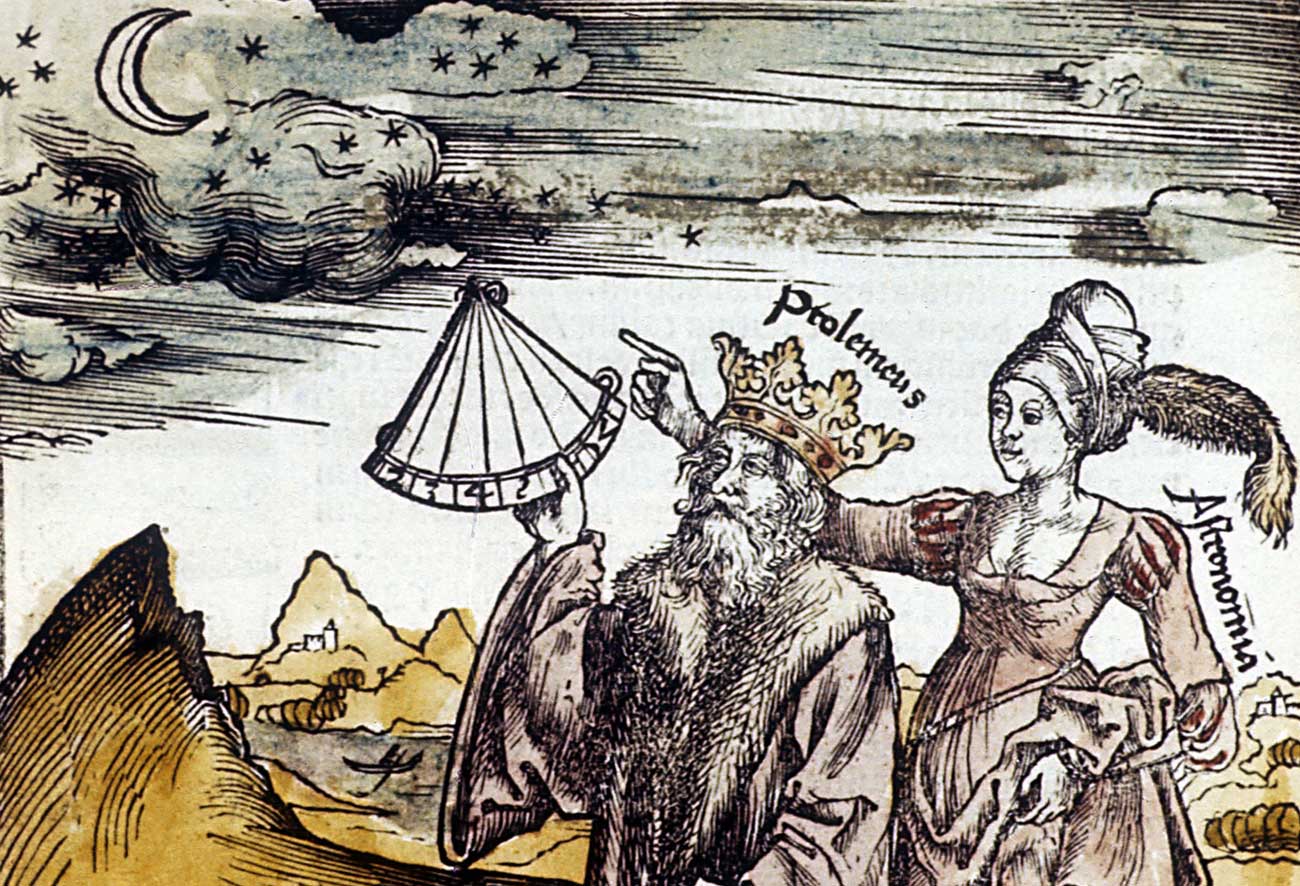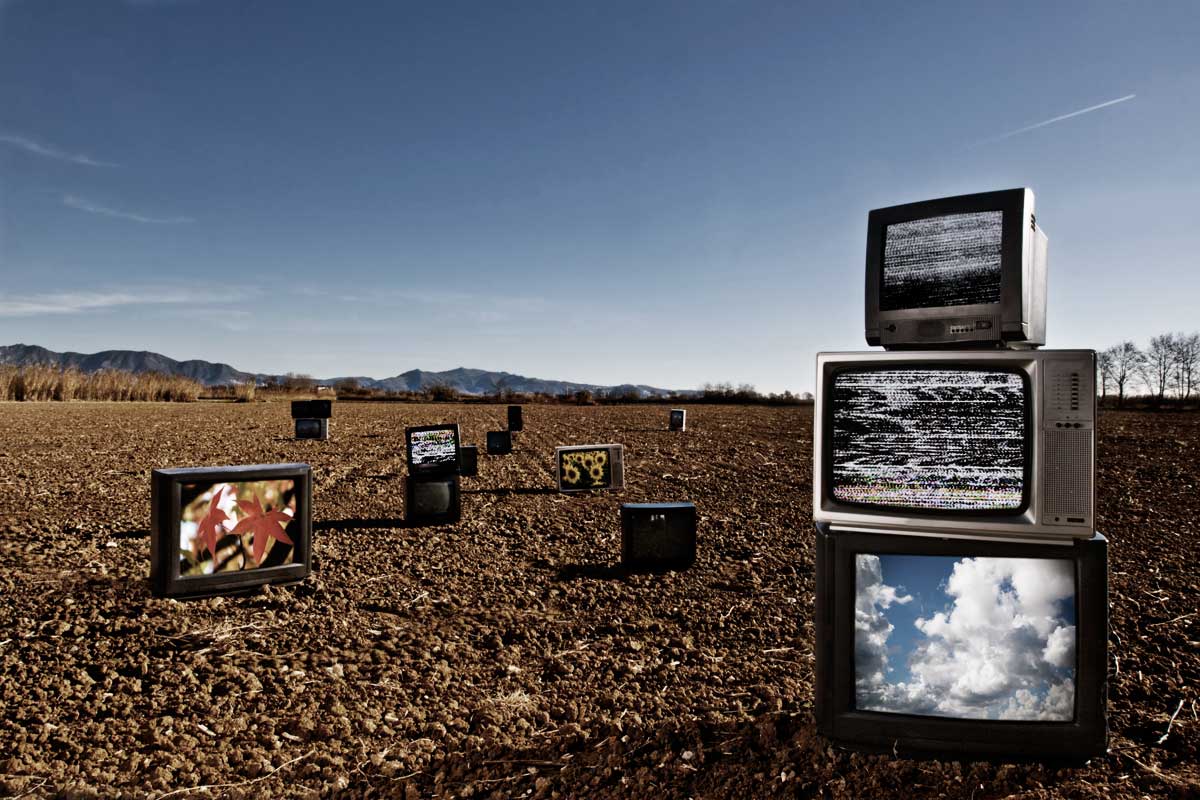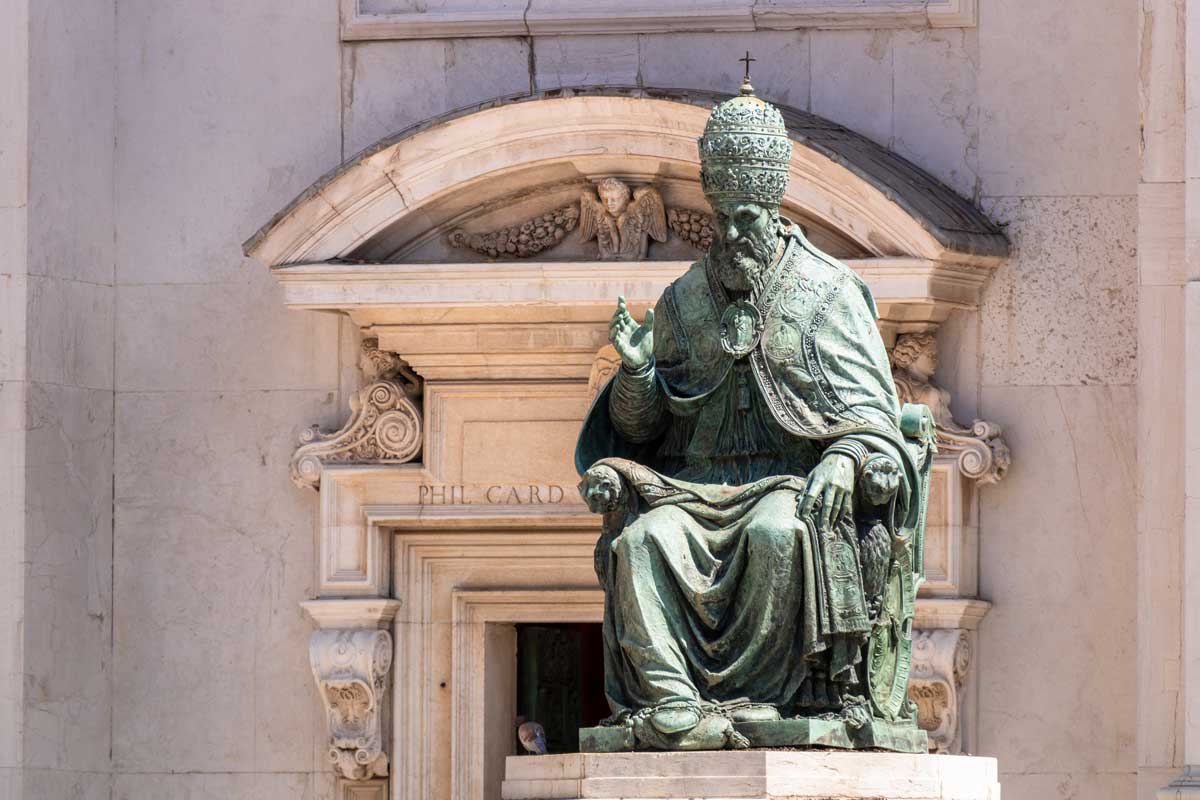Feature
Cosmic Centers
C. S. Lewis & the Insights of Medieval Cosmology
In his brief preface to The Discarded Image—his summary of what he calls the Medieval Model of the Universe—C. S. Lewis compares a certain kind of reader to "travellers who carry their resolute Englishry with them all over the Continent, mix only with other English tourists, enjoy all they see for its 'quaintness', and have no wish to realise what those ways of life, those churches, those vineyards, mean to the natives." This "tourist" mindset describes "those who prefer not to go beyond the impression, however accidental, which an old work makes on a mind that brings to it a purely modern sensibility and modern conceptions."
Those with such a mindset often make unconscious anachronisms, one of which is revealed in the modern belief that "geocentric is egocentric." This belief rests on the assumption that "center-hood" has always carried within it an essential priority, a primordial connotation of privilege. Hence, anyone who believes that the earth lies at the center of the cosmos and that the other heavenly bodies revolve around it also believes that the earth, and by extension the people on it, occupy the most privileged position in the universe. Since the Medievals were geocentric, they were also egocentric. Such is the popular modern notion concerning Medieval man's beliefs.
But it is not an accurate notion. For us moderns, geocentrism may be simply another manifestation of typical human egocentrism, but to the Medievals, the opposite was the case: "center-hood" for them implied an unenviably low position in the cosmic hierarchy.
Yet the modern notion that geocentrism has always been inherently anthropocentric, and therefore egocentric, is a largely unquestioned assumption. For example, a popular work on astronomy claims that, "for the longest time, we Earthlings reigned at the center of the universe. . . . And frankly, we loved believing that everything revolved around us. The earlier geocentric model was also a pleasantly egocentric model" (Star Struck: Seeing the Creator in the Wonders of Our Cosmos, 2016). And a current astronomy textbook describes "the Copernican principle" as the "removal of Earth from any position of great cosmic significance" (Astronomy Today: Volume Two: Stars and Galaxies, 2018).
Such passages echo the voices of the early moderns who first invented this narrative. Bernard le Bouvier de Fontenelle wrote in the late seventeenth century: "I am extremely pleased with [Copernicus] for having humbled the vanity of mankind, who had usurped the first and best situation in the universe." De Fontenelle goes on to explain the root cause of the geocentric blunder, saying, "the same inclination that makes us endeavor to have the first place in a ceremony prevails with a philosopher, in composing his system, to place himself in the center of the world if he can" (found in The Book of the Cosmos, D. R. Danielson, ed., 2000).
In this last quotation, especially, we have a clear example of what Lewis calls "Bulverism," the practice of overlooking someone's reasons for holding the view he does and instead attributing his belief to some personal cause, as echoed in the familiar accusation, "You only believe that because. . . ." The notion that believers in the geocentric model of the universe held that belief because of their naïve egocentrism has long since been assumed as a fact.
A Peculiarly Degraded Position
This modern notion does not, however, reflect what Medievals actually thought about themselves. As Arthur O. Lovejoy points out in The Great Chain of Being (1960)—a work Lewis cites three times in The Discarded Image—contrary to modern assumptions, geocentric cosmology was based on "the Aristotelian notion that the central position is a peculiarly degraded one." Lovejoy elaborates:
For the centre of the world was not a position of honor; it was rather the place farthest removed from the Empyrean [the highest sphere and home of the divine], the bottom of creation, to which its dregs and baser elements sank. The actual centre, indeed, was Hell; in the spatial sense the medieval world was literally diabolocentric [devil-centered].
We see the spiritual meaning of this cosmology explored in Dante's Divine Comedy. In that work, in the spiritual hierarchy of the world, the earth hovers between Limbo, the courtyard of the Inferno, and Purgatory, the courtyard of Paradise. Going further "up" means approaching Holiness himself; going "down," toward the "center," means approaching the deepest circle of hell, where Lucifer is lodged eternally.
Lovejoy goes on to reference an argument made in 1640 by John Wilkins against the Copernican model, which speaks of "the vileness of our earth, because it consists of a more sordid and base matter than any other part of the world; and therefore must be situated in the centre, which is the worst place, and at the greatest distance from those purer incorruptible bodies, the heavens." Lovejoy concludes that "it is sufficiently evident from such passages that the geocentric cosmography served rather for man's humiliation than for his exaltation, and that Copernicanism was opposed partly on the ground that it assigned too dignified and lofty a position to his dwelling-place."
Here we must follow Lewis's example of intellectual hospitality, for the idea that the center is not a position of privilege but of baseness is so counterintuitive to the modern mind that it is in danger of being dismissed as absurd. We assume that "center" has one objective and agreed-upon figurative meaning, that of privilege and priority, and that it has always had this meaning and thus constitutes a primordial archetype. But it is not so. Our beliefs about the meaning of "center-hood" are, in fact, historically conditioned, and they rest upon a set of assumptions, including cosmological assumptions, that the Medievals did not share.
As Lewis teaches us in The Discarded Image, intellectual hospitality involves a real effort of the imagination. Conceptions of the true nature of Medieval cosmology "need to be seized in an intuition." Further, "if the reader will suspend his disbelief and exercise his imagination upon it even for a few minutes, I think he will become aware of the vast re-adjustment involved in a perceptive reading of the old poets. He will find his whole attitude to the universe inverted." Lewis advises such a reader to "go out on a starry night and walk about for half an hour trying to see the sky in terms of the old cosmology." This is what we must do now. We must try to imagine what the "center" means in the Medieval Model.
The Source of Misunderstanding
To understand how it could be that the center was not considered a place of privilege in the Medieval mind, we must examine some of our typically modern assumptions. While the early moderns responsible for the invention of the "geocentric is egocentric" narrative may have had any number of things in mind, the following discussion is geared to what the average twenty-first-century Westerner actually imagines.
This person thinks of the world in a Newtonian way, which is, in fact, a late-seventeenth-century way—Newton's Principia was first published in 1687. The center of the solar system is its most massive object. (We moderns can speak intelligibly of a "solar system," that is, a gravitational system, in the Newtonian sense; the Medievals knew of no such system because they lacked the requisite notion of gravity.) The most massive object is at the center—actually at one foci of each of the planets' elliptical orbits—because its prodigious mass makes for a considerable gravitational force between it and the objects around it. This force results in a much greater acceleration in the less massive objects and causes them to fall into orbit around it.
In other words, the planets orbit—that is, fall around or accelerate around—the massive body that holds them in its grip. (Actually both the planets and the sun orbit around the center of mass of the gravitational system known as the barycenter, but this fact does not usually impress itself on the imaginations of average twenty-first-century people). Therefore, the center is a place of privilege because it is the place of power. It accounts for the presence and coherence of the entire gravitational system; if the sun suddenly disappeared, the planets would fly off in a direction tangential to their orbit at that moment.
The average modern Westerner has something like this in the back of his mind when he thinks of the center of the solar system. When he hears of the older geocentric model, he assumes anachronistically that his modern notions were present in the Medieval mind as well. He thus infers, vaguely and unconsciously, that belief in a geocentric model means belief in the privileged location of the earth, an evaluative intuition that remains even after he learns that the Medievals did not have the Newtonian notion of gravity that underlies his view. The modern saying, "You think the universe revolves around you, don't you?" hangs in the background, influencing his interpretation. This is surely the source of at least some of the enduring misunderstanding of Medieval cosmology.
Pride of Place
Even a brief consideration of the differences between Medieval cosmology and the modern Newtonian view is sufficient to show why the center is not privileged in the former. For Newton, space is passive; mass is active. Locomotion is the result of force acting on mass (causing acceleration) and inertia (the quality by virtue of which mass tends to maintain constant velocity). The orbits of the planets are due to the force of gravity, which causes them to maintain their acceleration around the sun.
But in the Medieval Model, following Aristotle, it is place (not mass) that is the active source of influence (not force). In his Physics Aristotle writes, "the typical locomotions of the elementary natural bodies—namely, fire, earth, and the like—show not only that place is something, but also that it exerts a certain influence. Each is carried to its own place, if it is not hindered, the one up, the other down." Lewis adds that the objects themselves are not merely acted upon by an impersonal force but that they exhibit what the Medievals called "kindly enclyning" toward their natural place.
Thus, the "gravity" of falling elements (like earth), as opposed to the "levity" of rising elements (like fire), is not at all what we post-Newton people mean by "gravity." The Aristotelian and Medieval notion is more like what we would call "density"; it is the quality that separates oil and water and that makes sand settle into different layers of sediment when shaken up in a jar of water. Lewis describes it this way: "whatever was purest and most limpid (liquidissimum) rose to the highest place and was called aether. That which had less purity and some small degree of weight became air and sank to the second level."
What we have here is a hierarchical notion of purity, which causes the material in the universe to form layers or, in Medieval terms, "spheres." This is a far cry from the Newtonian notion of gravity, and it explains why centrality did not have the kind of associations that it has for moderns.
There was also no notion that this quality, whether we call it gravity or density, emanated from the earth to the other planets, as we would say gravity emanates from the sun. Rather, the planetary spheres (since, of course, there is no conception of orbit in the Medieval Model) issued their influence down to earth. In fact, Lewis tells us,
all power, movement, and efficacy descend from God to the Primum Mobile [the "first-moving" sphere] and cause it to rotate. . . . The rotation of the Primum Mobile causes that of the Stellatum [the sphere of the fixed stars], which causes that of the sphere of Saturn, and so on, down to the last moving sphere, that of the Moon.
This is the exact opposite of the Newtonian model, for here, rather than all movement being caused by the force of a massive object in the center of a gravitational system, we have a top-down system, where all the influence comes from the outside, from God, and trickles down through creation, through spheres that are less and less pure the lower they are in the system. We are now in a position to understand why "earth is in fact the 'offscourings of creation,' the cosmic dust-bin," as Lewis writes. It is as if the earth were at the "bottom of a stair," and man found himself looking up (in all directions) to see the activity of his betters.
A Relatively New Concept
The mode of imagination that accompanies this cosmology is one that privileges height, not centrality; the ancients and Medievals were hierarchically minded. Lewis points out that moderns think of the stars as being "at a great distance," but if you want to enter the Medieval mindset, "for distance you must now substitute that very special, and far less abstract, sort of distance which we call height; height, which speaks immediately to our muscles and nerves."
It is telling that the ancients never associate pride or praise or privilege with centrality; rather, they associate these things with height. St. Paul speaks of the proud as "puffed up" or "lifted up," and of Christ as "highly exalted." The Latin Vulgate, the Bible translation made by St. Jerome
in the fourth century and the only biblical text accessible to most Christians in the West through the Middle Ages (only a handful knew Greek), translates these terms with verbs like inflati sunt (cf. "inflation") or exaltavit (cf. "exalt"). The angels of the Nativity sing of God being in excelsis or in altissimis, "in the highest." When St. Thomas Aquinas, in the thirteenth century, speaks of the vice of pride, he uses the Latin term superbia, meaning "over" or "above," though it could also mean "loftiness."
By contrast, etymologically speaking, words like "egocentric" and "self-centered" are relatively recent developments, suggesting that the association of centrality with honor, privilege, and pride is also recent. The word "egocentric" does not appear until 1894. "Self-centered" emerges in English much earlier, in about 1645, but notably, this is about the same time as the emergence of the modern narrative about Medieval cosmology. "Self-centered" appears to be one of a number of "self-" words that arose in this period. Even "selfishness," which predates and probably made possible the notion of "self-centeredness," does not appear until the 1630s.
So, for example, where we are admonished against "selfish ambition" in twentieth-century translations of James 3:16 and Philippians 2:3 (e.g., the ESV, NIV, NASB, and NLT), the King James Version (1611) warns against "strife" and the Vulgate against contentio, from which we get the word "contention." The idea that this strife or contention might be due to something called selfish ambition is a later inference.
The exact notion of selfishness probably did not even exist in ancient times. The ancients had notions of hubris, greed, and pride, but they lacked the modern notions of selfishness and self-centeredness. We moderns read the myth of Narcissus, for instance, as a study in self-absorption, but that is a modern psychoanalytic reading, not an ancient one. Even what we might cite as the paradigmatic case of egocentrism and self-centeredness—St. Augustine's description of his own tyrannical rage as an infant demanding his mother's milk—was not such for Augustine, who had no concept of "selfishness"; he identifies the vices involved as gluttony and jealousy. The distinctly modern notion of selfishness that undergirds words like "self-centered" and "egocentric" thus betrays the recent origin of the association of centrality with honor and pride.
Yet, while these words and notions may be modern, the kinds of moral corruption they signify have something in common with the older vices of pride and a lack of concern for others, which the Medievals were familiar with. But when confronting such vices, mothers in the Middle Ages did not have to inform their children, "The universe does not revolve around you," because their children wouldn't have wanted to be in such an unfortunate position anyway. To them, to be "revolved around" was to be superseded, not deferred to, while to "revolve around" was to be (literally) "superior." Indeed, the planets in their heavenly spheres were the sources of influence and therefore "the dispensers of fate." If Medieval mothers were to adopt a modern idiom, they would more likely exhort proud children to be "more down-to-earth."
It is likely—though it would require more work in intellectual history to confirm—that the notion of self-centeredness itself arose out of the narrative that the early moderns composed about the Medieval system; that is, the notion was probably only made possible by post-Copernican narratives. The new-found association of honor with centrality was then applied to the Medieval Model anachronistically, and the Medieval association of honor with inflation and elevation was forgotten.
Merely Suburban
With this understanding of the Medieval mind in place, we can understand why Medieval comments about the earth's position in the universe are, ironically, strikingly similar to those of twentieth-century cosmologists. Lewis especially admires "the exquisite touch which denies our species even the tragic dignity of being outcasts by making us merely suburban." To the Medievals, the earth was "suburban" because the real locus of activity in the universe was found in the heights of the Empyrean, the sphere of the divine, and we are farthest from it.
Though based on different grounds, this is the same estimation that the earth receives from modern cosmologists. For example, Stephen Hawking comments that "the human race is just a chemical scum on a moderate-sized planet, orbiting around a very average star in the outer suburb of one among a hundred billion galaxies." Interestingly, Hawking chooses the same term as Lewis to characterize the position of the earth: "suburban." While the scales of number and distance involved in Hawking's description are orders of magnitude greater than those that would have been present in the Medieval mind, we may fairly say that they are not, in a certain sense, appreciably greater. As Lewis explains:
[T]he fact that the height of the stars in the medieval astronomy is very small compared with their distance in the modern, will turn out not to have the kind of importance you anticipated. For thought and imagination, ten million miles and a thousand million are much the same. Both can be conceived (that is, we can do sums with both) and neither can be imagined. (DI, 98–99)
Similarly, when Lovejoy speaks of "the terrestrial magnitudes which furnish the scale for the imagination" he is acknowledging a limit that applies to modern men just as it did to the Medievals. This is why Hawking's language of "suburb" matches that of Lewis and his Medieval sources; it is only through such images that human minds can make sense of distance and relative position. The import of the image is the same for both moderns and Medievals, showing that both have a similar understanding of the earth's position.
The Real Egocentrists
Ironically, the early heliocentrists, men of the Renaissance, held a high view of man and rejoiced to move him out of his base position at the center of the universe. In his pamphlet describing his telescopic discoveries, Sidereus Nuncius ("The Starry Messenger," 1610), Galileo writes, "I will prove that the earth does have motion, that it surpasses the moon in brightness, and that it is not the sump where the universe's filth and ephemera collect." Here he obviously assumes the Medieval belief that the "center" is the "sump," and he is making a point of rescuing the earth from this sad position.
Kepler, too, though he is beginning to think in more modern terms—he speaks of the sun as the "origin of . . . cosmic motion" and the "instigator of all the motions," and says that "the force which rules the world is revealed in the sun"—nevertheless retains a strong anthropocentrism. He writes that "in the interests of that contemplation for which man was created, and adorned and equipped with eyes, he could not remain at rest in the center. On the contrary, he must make an annual journey on this boat, which is our earth, to perform his observations." In other words, the earth is a vehicle, a tool, for astronomers like Kepler; that is why it could not be "stuck" at the center. And although Kepler came to the modern conclusion that the center is a place of honor just as the earth was being removed from it, he attempted to soften the blow, saying, "after the sun, however, there is no globe nobler or more suitable for man than the earth. For, in the first place, it is exactly in the middle of the principal globes" (i.e., there are three globes on either side of it: the sun, Mercury, and Venus on one side, and Mars, Jupiter, and Saturn on the other—Uranus and Neptune had not yet been discovered).
Thus, among these early heliocentric thinkers, the anthropocentrism so typical of the Renaissance—as revealed, for example, in Pico della Mirandola's Oration on the Dignity of Man—rears its head in cosmology, too. But this marks a shift away from the Medieval Model; it is not a defining feature of it, as some moderns would later suggest.
Science or History?
Having surveyed the history of the notion of geocentrism, and considered the features of the Medieval Model that account for its conception of the center as a lowly place, we can now consider two objections that might arise—objections that, at the same time, present an opportunity to analyze the relevance of the foregoing discussion to modern thinking about the universe.
First, it might be objected that this discussion has not been about science per se but about history. What people used to think about these things cannot be thought of as science because such ideas are out of date, and all out-of-date science is reduced to mere history.
This objection overlooks something fundamental about the way science functions, and it reveals something problematic about the way we present the history of science.
The textbook Astronomy Today describes the development of science this way: "as the influence of logic and reasoned argument grew, the power of myth diminished." In The Structure of Scientific Revolutions, Thomas Kuhn observes that this kind of approach leads to treating history as a mere "repository" for "anecdote or chronology." It encourages a narrative of "development-by-accumulation," where the historian has only to "determine by what man and at what point in time each contemporary scientific fact, law, and theory was discovered or invented" and to "explain the congeries of error, myth, and superstition that have inhibited the more rapid accumulation of the constituents of the modern science text."
This approach to history is the same one that Lewis rejects in his preface to The Discarded Image; it reveals a "presentist" view of history—the belief that history is merely the story of how we got to us. But as Kuhn points out, such boundaries between "fact" and "myth" in historical situations are not as clear as we might think. He writes:
The more carefully [historians of science] study, say, Aristotelian dynamics, phlogistic chemistry, or caloric thermodynamics, the more certain they feel that those once current views of nature were, as a whole, neither less scientific nor more the product of human idiosyncrasy than those current today. If these out-of-date beliefs are to be called myths, then myths can be produced by the same sorts of methods and held for the same sorts of reasons that now lead to scientific knowledge.
Kuhn concludes that "out-of-date theories are not in principle unscientific because they have been discarded." If he is right, then Lewis's description of one such "discarded image" may well be considered as dealing with science, even though the paradigms involved no longer hold sway. Otherwise, the only way to speak intelligibly of "Medieval science" would be to find things in it that we still consider scientifically viable, dismissing the rest as "myth."
A Question of Significance
Second, it might be objected that while Medieval geocentrists may have had a humble view of their position, the mere fact that the earth was "on the cosmic map" at all still constitutes an expression of anthropocentrism and therefore egocentrism. This objection moves past the prior discussion and tackles something much deeper: the very notions of order and finitude as they appear in Medieval thought.
The spirit of the objection seems to be that the modern view—which involves vast, unimaginable, and possibly infinite cosmic spaces populated by hundreds of billions of similar and unremarkable galaxies, stars, and planets—thoroughly removes us from any significant point of reference and thus humbles us far more than the Medieval view did. But the actual effect of this view on the human psyche is otherwise. In the modern universe, man has not so much been de-centered as disoriented; he is not so much humbled as lost. The result is expressed by Pascal when he admits, "the eternal silence of these infinite spaces frightens me," and by Nietzsche when his character the madman asks, "Is there still an above and below? Do we not stray, as through infinite nothingness?" While for the Medievals there was an "absolute Up and Down," for the moderns there is no such absolute directionality, no standard by which to measure our rank or station, leaving that question open to our subjective whims and fears.
Nor is man really any smaller. In fact, it is only in the old view that man could be either small or large, for in the modern view there is no authoritative scale or point of reference to measure him by. Pascal observes that in the modern view, man is "a Nothing in comparison with the Infinite, an All in comparison to the Nothing"; he is "a mean between nothing and everything." G. K. Chesterton puts the point succinctly when he quips that "it is quite futile to argue that man is small compared to the cosmos; for man was always small compared to the nearest tree." Thus, the modern understanding of the cosmos does not necessarily result in a humbling or diminution of man to a greater degree than the Medieval understanding did.
Recovering the Discarded Image
In The Discarded Image, Lewis both exhorts and equips his readers to carry on his example of intellectual hospitality. If we do, we'll find that we are able to understand Medieval cosmology with new depth, for we will have realized and suspended the modern assumptions that have produced common mischaracterizations.
The geocentric model of the universe was not anthropocentric. Rather, the center was a suburb, a dust-bin, a sump—the place where the scum of the universe collected. The ideological changes that occurred in the Renaissance and early modern period caused this history to be forgotten and produced the notion with which we are now familiar, that "geocentric is egocentric." Following Lewis, we can free ourselves of this modern myth and recover what we can from the discarded image of Medieval cosmology.
Phillip Piper is a recent graduate of the Templeton Honors College at Eastern University, St. Davids, Pennsylvania, and is currently a Ph.D. student in philosophy at the Catholic University of America in Washington, D.C. He is originally from Kitchener, Ontario, Canada. When at home, he attends his childhood church, First Baptist Church in Waterloo, Ontario.
subscription options
Order
Print/Online Subscription

Get six issues (one year) of Touchstone PLUS full online access including pdf downloads for only $39.95. That's only $3.34 per month!
Order
Online Only
Subscription

Get a one-year full-access subscription to the Touchstone online archives for only $19.95. That's only $1.66 per month!
bulk subscriptions
Order Touchstone subscriptions in bulk and save $10 per sub! Each subscription includes 6 issues of Touchstone plus full online access to touchstonemag.com—including archives, videos, and pdf downloads of recent issues for only $29.95 each! Great for churches or study groups.
Transactions will be processed on a secure server.
more on C. S. Lewis from the online archives
more from the online archives
calling all readers
Please Donate
"There are magazines worth reading but few worth saving . . . Touchstone is just such a magazine."
—Alice von Hildebrand
"Here we do not concede one square millimeter of territory to falsehood, folly, contemporary sentimentality, or fashion. We speak the truth, and let God be our judge. . . . Touchstone is the one committedly Christian conservative journal."
—Anthony Esolen, Touchstone senior editor













